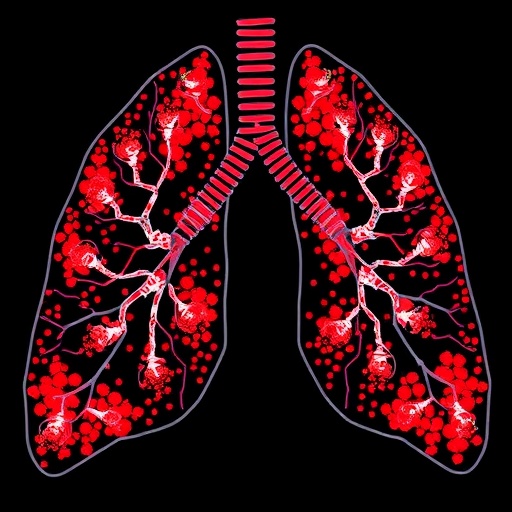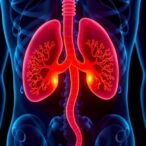
In recent years, the landscape of cancer diagnostics has been revolutionized by advances in next-generation sequencing (NGS) technologies, enabling a more precise and comprehensive understanding of molecular alterations driving tumor development. A groundbreaking study published in BMC Cancer now brings to light the powerful application of targeted NGS in the real-world clinical setting, specifically focusing on Asian patients suffering from non-small-cell lung cancer (NSCLC). This extensive investigation leverages the Oncomine Focus Assay (OFA) to decode the genetic intricacies of NSCLC, shedding important light on the utility and performance of this technology in precision oncology.
Non-small-cell lung cancer remains a leading cause of cancer-related mortality worldwide, and Asia, particularly regions such as Taiwan, is disproportionately affected by diverse molecular subtypes that necessitate tailored therapeutic approaches. The study’s retrospective design encompassed 478 Taiwanese NSCLC patients, spanning five years, thereby providing unparalleled insight into the genetic heterogeneity of the population. Using the OFA platform, researchers systematically interrogated key driver mutations and complex genomic rearrangements, aiming to optimize clinical diagnostics and patient management.
One of the most striking outcomes of the investigation is the platform’s high success rate, successfully sequencing 80.5% of patient specimens. Achieving such a rate in real-world clinical samples is notable, as variables like tumor cell percentage, specimen source, and the age of formalin-fixed, paraffin-embedded (FFPE) tissue blocks are known to impact sequencing quality and accuracy. The study meticulously analyzed these factors, underscoring their pivotal roles in ensuring reliable NGS results. This highlights the importance of pre-analytical considerations in clinical sequencing workflows.
Performance metrics of the OFA further attest to its robustness. Sequencing runs demonstrated exceptional on-target alignment, reaching an average of 97.0%, an indicator that the assay efficiently captures relevant genomic regions with minimal off-target noise. Uniformity, a critical measure reflecting even coverage across targeted amplicons, averaged 94.7%, while coverage depths exceeded 500× for over 98% of these regions. Together, these metrics reveal the assay’s capacity to generate high-quality, reproducible genetic data crucial for clinical decision-making.
Within the successfully analyzed cohort, the prevalence of pathogenic or likely pathogenic variants was remarkably high at 86.8%, revealing the profound molecular diversity resident within Asian NSCLC patients. Mutations were cataloged across various classes: single nucleotide variants (SNVs) and small insertions/deletions (Indels) dominated, representing 78.4% of genetic alterations detected. Copy number variations (CNVs) were also prominent, appearing in 41.6% of patients, illustrating the complex genomic rearrangements contributory to tumorigenesis. Notably, the assay could detect rarer events such as exon skipping and gene fusions, which are increasingly recognized as vital oncogenic drivers amenable to targeted therapies.
The spectrum of actionable driver mutations detected corroborates and extends existing epidemiological data on NSCLC in Asian populations. EGFR mutations were observed in 46.2% of cases, reaffirming their status as the most prevalent oncogenic alterations in this demographic. The presence of other hotspots, including KRAS (9.4%), ERBB2 (6.8%), and BRAF (2.3%) mutations, paints a multifaceted picture of tumor biology. Additionally, detecting ALK fusions (4.4%) and MET exon 14 skipping alterations (2.3%) adds to a growing catalog of genomic aberrations with approved targeted therapies or drugs under clinical evaluation.
A particularly intriguing finding concerns the KRAS G12C mutation, present in 2.8% of the cohort. This mutation has recently garnered significant clinical interest due to the development of specific inhibitors, marking a shift in previously undruggable targets towards actionable vulnerabilities. Its identification in an Asian NSCLC population signals the importance of including this biomarker in routine molecular profiling, enabling a broader patient base to benefit from emerging treatments.
The study’s implications extend beyond biomarker detection; it affirms the Oncomine Focus Assay’s clinical utility in integrating genomic analyses into routine care. The combination of robust performance metrics and comprehensive variant detection capabilities offers oncologists a reliable tool to tailor therapies, navigate resistance mechanisms, and monitor disease progression. By validating this platform in a real-world setting, the research bridges the gap between technological innovation and tangible patient outcomes.
Moreover, the study addresses a gap in the literature concerning the clinical utility of different NGS platforms in NSCLC. Although multiple sequencing approaches exist, few have been comprehensively assessed within large, ethnically homogeneous cohorts, limiting the generalizability of findings. Through its rigorous evaluation of sequencing success determinants and genetic landscapes, this research provides a template for integrating targeted NGS into Asian clinical oncology practices, where unique genetic profiles may influence therapeutic responsiveness.
The integration of NGS into clinical workflows also prompts considerations surrounding tissue handling, sample quality, and turnaround times, all critical factors in delivering timely and actionable results for cancer patients. This study’s recognition of FFPE block age and tumor cell content as key modulators of NGS success underlines the necessity for standardized protocols and quality control measures to maximize assay efficacy in diverse clinical environments.
Furthermore, the detection of diverse genetic alterations, including gene fusions such as ROS1, RET, and the rare NTRK1 fusions, highlights the evolving paradigm in lung cancer treatment. The emergence of targeted inhibitors for these molecular events has transformed NSCLC care, offering patients personalized therapeutic options that improve outcomes and reduce systemic toxicity. The study reinforces the need for inclusive molecular panels capable of capturing the full gamut of oncogenic drivers.
As targeted therapies become more available and guidelines increasingly recommend molecular profiling, the scalability and robustness of assays like the OFA assume critical importance. The successful application of targeted NGS in a large-scale real-world cohort validates its role in supporting precision medicine. This alignment of diagnostic innovation with clinical needs promises to accelerate the adoption of bespoke therapies, ultimately contributing to improved survival and quality of life for patients.
In conclusion, this comprehensive study elucidates the value of targeted next-generation sequencing in unraveling the complex mutational architecture of Asian NSCLC. By demonstrating high analytical performance and detailed molecular insights, it underscores the transformative potential of precision oncology in regions with distinct genetic epidemiology. Such advancements pave the way for enhanced therapeutic stratification, improved patient outcomes, and a future where lung cancer care is increasingly individualized and effective.
Subject of Research: Targeted next-generation sequencing for molecular variant identification in Asian non-small-cell lung cancer patients
Article Title: Real-world application of targeted next-generation sequencing for identifying molecular variants in Asian non-small-cell lung cancer
Article References:
Wang, FY., Yeh, YC., Lin, SY. et al. Real-world application of targeted next-generation sequencing for identifying molecular variants in Asian non-small-cell lung cancer. BMC Cancer 25, 715 (2025). https://doi.org/10.1186/s12885-025-14016-z
Image Credits: Scienmag.com
DOI: https://doi.org/10.1186/s12885-025-14016-z
Tags: Asian non-small-cell lung cancer variantscancer diagnostics in Asian populationsclinical implications of targeted NGSdriver mutations in lung cancergenetic heterogeneity in NSCLCmolecular alterations in tumor developmentnext-generation sequencing advancementsOncomine Focus Assay applicationoptimizing patient management in cancer treatmentprecision oncology in Taiwanretrospective study of NSCLC patientstargeted sequencing in lung cancer


